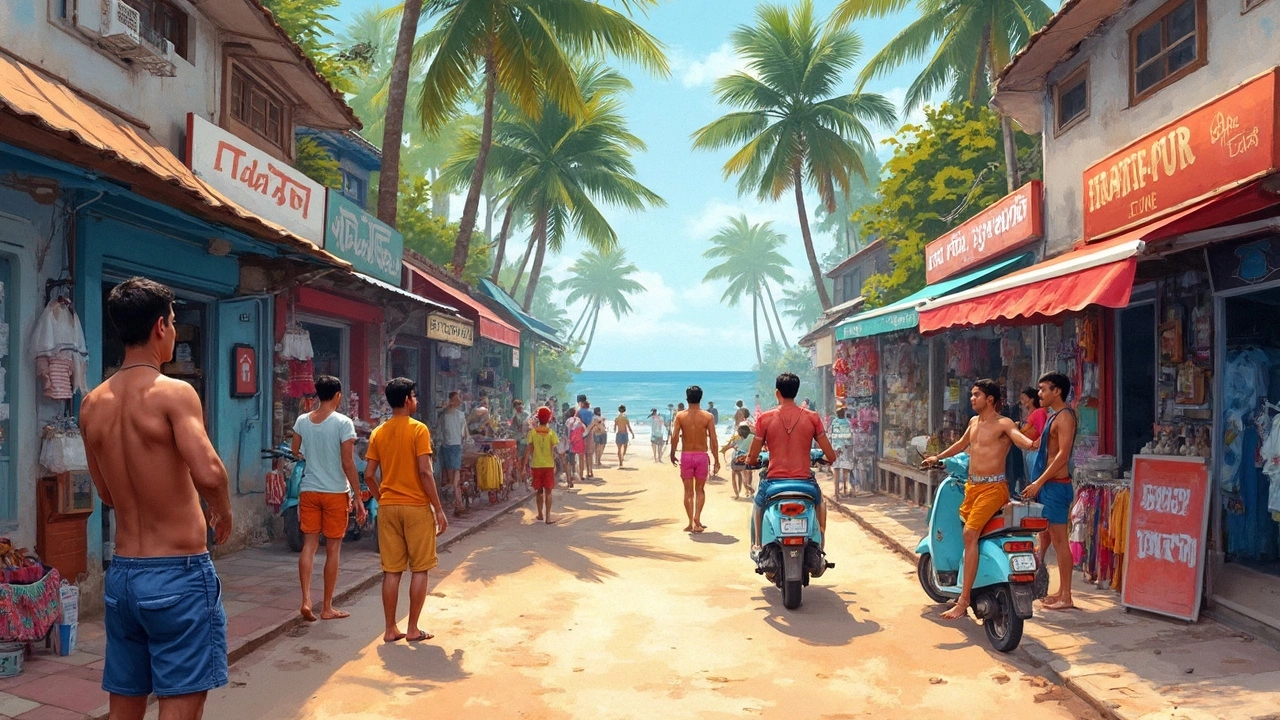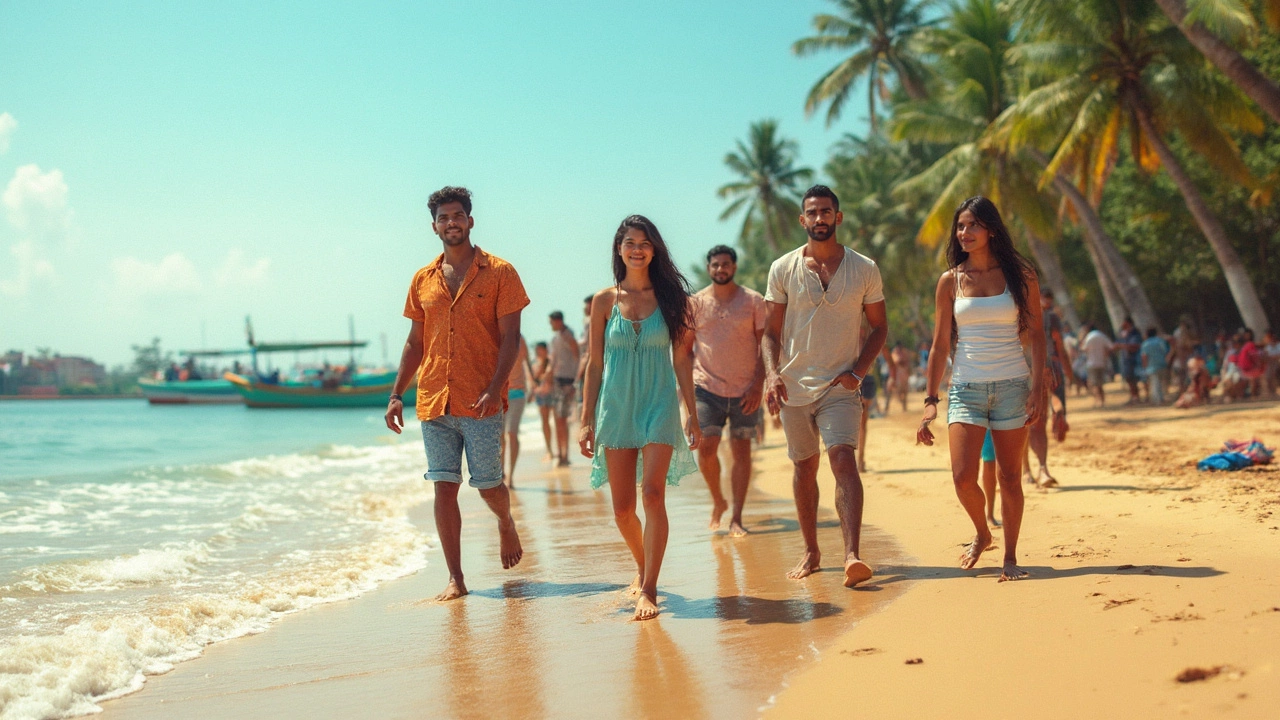If you’re dreaming of lounging in shorts on a Goan beach, good news: nobody’s going to give you the side-eye. That chilled-out vibe you’ve heard about? It’s real, at least along the coastline where tourists flock. Shorts are pretty much a uniform on Goa’s beaches, in cafes, and at shacks—nobody bats an eyelid if you’re strolling around in denim cut-offs or breezy cottons.
But pause before packing nothing but shorts. While they’re a no-brainer at beach spots, restrictions pop up once you step away from tourist hubs. Step into a market in Mapusa or a temple in Ponda, and things change fast. Locals cover up more, especially away from major tourist zones, so you might stand out (and not in a way that feels comfortable). There’s no strict dress code, but being a bit mindful goes a long way toward blending in and avoiding awkward stares.
- Goa’s Laid-Back Vibe: Shorts on the Beach and Beyond
- Understanding Where Shorts Work and Where They Don’t
- Smart Packing Tips: What to Bring Besides Shorts
- Etiquette For Tourists: Respect, Safety, and Local Norms
Goa’s Laid-Back Vibe: Shorts on the Beach and Beyond
When people talk about Goa, you always hear the words relaxed or easy-going. This especially rings true along the coastline, where the day-to-day feels made for lounging. Here, shorts in Goa aren’t just accepted—they’re everywhere. Step out onto Anjuna, Baga, or Palolem beach, and you’ll see a mix of locals, backpackers, and vacationing families, all dressed in shorts, tank tops, or sundresses. Nobody cares if your shorts are denim, linen, ripped, or brand new—comfort overrules everything else.
Beach towns in Goa have been shaped by decades of international tourism. You’ll find yoga classes at sunrise, reggae bars at sunset, and street markets full of travelers in casual clothes. In places like Calangute or Vagator, nearly every café is filled with chilled-out folks in easy, breathable outfits. Even local Goans have adapted the style, especially those working with tourists.
Worried you’ll stand out? Don’t be. Wearing shorts in Goa is as normal as carrying sunscreen. In fact, if you show up overdressed, you might feel more out of place than anyone else. A lot of women (locals and travelers) wear shorts, skirts, or beach dresses. Guys pair them with T-shirts or loose shirts. It’s all about beating the heat; it gets hot here, especially from October through May.
Here’s a quick look at what people typically wear in different settings in Goa:
| Where | What Locals & Tourists Wear |
|---|---|
| Beaches & Beach Cafes | Shorts, swimsuits, tank tops, flip-flops |
| Markets & Town Areas (Tourist Zones) | Shorts, skirts, sundresses, T-shirts |
| Clubs & Nightlife | Dressier shorts, smart casual, sundresses, jeans |
The only time you’ll need to rethink shorts is if you’re heading more inland—think spice farms, small local villages, or religious sites. But when you stick to the beach belt, staying comfy in shorts is just part of living your best Goa life.
Understanding Where Shorts Work and Where They Don’t
Walking along Baga Beach in your shorts in Goa? You’ll fit right in with the crowd. The beach shacks, party zones, and most hotels don’t care what you wear—as long as you’re comfortable. Even in places like Anjuna, Candolim, and Vagator, shorts are the go-to for both locals and tourists. It’s almost expected by the sea.
Head away from the coast and it’s a different story. In the city centers like Panjim, or older towns inland, Goa dress code becomes more conservative. Shorts that work at the beach can make you stick out fast. Woman or man, if you head into government buildings, banks, or local restaurants in rural villages, go for at least knee-length shorts (or better yet, light trousers or a skirt for women). It’s not about being judged harshly, but about showing some respect for local culture.
Religious sites are a strict no-go for shorts. Temples and churches will usually stop you at the door if your knees or shoulders aren’t covered. Signs at places like the famous Mangueshi Temple say it outright: “No Shorts Allowed.” Even if no one says anything, you’ll instantly notice the difference in what others are wearing.
“Goa is easy-going, but our traditions matter. Shorts are fine at the beach, but cover up at temples or old villages,” says travel guide Nilesh Borkar, who’s taken tourists across the region for 15 years.
Take clubs and parties, for example. In touristy nightclubs, shorts are a common sight, but fancy places in Panjim or five-star hotel bars might have their own Goa dress code—some say no to shorts after 7 p.m. Always double-check your spot’s rules, because being turned away at the door is an awkward way to start a night.
Here’s a cheat sheet to keep it simple:
- Shorts are absolutely fine: Beaches, beach cafes, touristy flea markets, most beach bars, scooter rides near the shore.
- Think twice or wear longer: City centers, non-touristy restaurants, public transport, government offices.
- Cover up required: Temples, historic churches, and heritage sites. Bring a wrap or switch to pants or a maxi skirt.
If you want to play it safe during the hottest months (March to June, with average highs around 33°C), breathable long options are a lifesaver when you want to respect local norms but stay cool.
| Place | Shorts OK? | Notes |
|---|---|---|
| Beach/Shack | Yes | Any style, any length |
| Panjim Market | Maybe | Longer shorts better |
| Temple | No | Full coverage needed |
| Fancy Bar | Check | May require trousers/skirts |
| Village Area | Maybe | Err on the side of caution |
Pack a mix of easy shorts for the coast and a few lightweight cover-ups for when you explore further. You’ll always be ready for whatever Goa throws your way.

Smart Packing Tips: What to Bring Besides Shorts
Even if you can rock your shorts in Goa most of the time, having some backup outfit options is smart—especially if you want to explore more than just the beaches. Packing right saves you hassle and helps you fit in.
Here’s a no-nonsense packing list for Goa:
- Loose cotton pants or palazzos: Perfect for markets, city walks, or late-night strolls. They’re cool, cover you up, and no one blinks if you wear them into a temple or church.
- Lightweight scarf or stole: Easy to tuck in your bag, and a lifesaver if you find yourself somewhere that expects covered shoulders (like religious sites or government offices).
- Sundresses and long skirts: These work on and off the beach. Midi or maxi length is best for trips to Old Goa or busy towns.
- T-shirts and tank tops: Great for mixing and matching with your shorts or pants. Just avoid super revealing tops outside beach zones to keep things respectful.
- Swimwear: Obvious, but here’s a tip: save bikinis for the actual beach. Bring a cover-up or sarong for the walks between your shack, the sand, or the bar.
- Flip-flops and comfortable sandals: You’ll walk more than you think. Goans love their practical shoes because of sandy floors everywhere.
Most travelers end up shopping for clothes in Goa anyway—the flea markets and street stalls sell comfy, cheap clothes made for the weather. If you forget something, you can find it locally for a fraction of what you’d pay at home.
| Item | Where to Wear |
|---|---|
| Shorts | Beaches, tourist towns, resorts |
| Long pants/skirts | Temples, churches, local markets |
| Swimwear | Beach only, with cover-up elsewhere |
| Scarf/stole | Religious sites, sun protection |
If you're planning to visit both Goa’s dress code hotspots—like the hipster hangouts in North Goa—and family-run cafés or more old-school spots in South Goa, you’ll want to switch up your look fast. So, variety helps! The key is packing light, layering, and thinking about where you plan to go after you leave the beach.
Etiquette For Tourists: Respect, Safety, and Local Norms
If you want a drama-free holiday in Goa, you need to keep a few common sense rules in mind—especially about what to wear beyond the beach. Goa dress code isn’t exactly strict, but it’s different if you’re visiting temples or walking around local villages. Here’s a pro tip: grab a light scarf or sarong to wrap around your shorts if you suddenly find yourself in a place that’s more traditional. Most Goans are cool, but people will appreciate your effort to blend in when you’re away from tourist hotspots.
There’s also the safety aspect. Honestly, most of North Goa is safe for women and men in shorts during the day, but you shouldn’t push your luck late at night or in quieter areas. Petty theft exists, so keep your phone and wallet handy. According to the Goa Tourism Department, thefts from unattended bags on beaches are reported every single week in season. Leaving your stuff while you swim is way riskier than what you’re wearing.
Here are a few quick etiquette pointers for shorts in Goa—so you never feel out of place or unsafe:
- Beach? Wear what you want. Beachwear, including shorts, is fine.
- Temples, churches, or government offices? Cover up—no shorts, tank tops, or revealing clothes. A long skirt or pants will save you every time.
- Markets and small towns? Opt for knee-length shorts at least, if you wear them at all. Locals are used to tourists but still dress modestly themselves.
- Avoid topless sunbathing—it's illegal in India and gets you unwanted attention.
- If you’re renting scooters or bikes, shorts are fine, but wear longer ones to avoid scrapes from falls or sunburn.
Here’s a quick look at where shorts work, and where they absolutely don’t:
| Location | Shorts Allowed? |
|---|---|
| Beach / Beach Shack | Yes |
| Upscale Restaurant | Usually, but check if there’s a dress code |
| Hindu Temple | No |
| Church | Sometimes, but long shorts or trousers preferred |
| Local Market | Yes, but keep them knee-length |
If you’re ever in doubt, just look at how local women are dressed. Or do what I do—ask a local. They’ll set you straight fast and usually appreciate your respect. As one travel blog, India Someday, puts it:
"It’s about being a good guest—Goans are famously welcoming, but a little cultural awareness goes a long way toward getting an even warmer reception."
So, what to wear in Goa? Pack for fun, but don’t forget those places where local life and tradition still rule. If you’re respectful—while staying comfortable—you’ll fit right in, and have a better trip for it.
